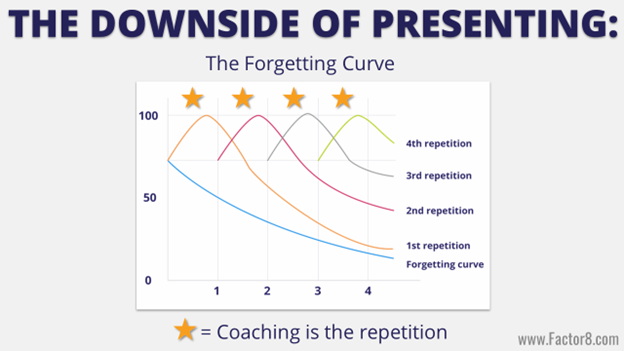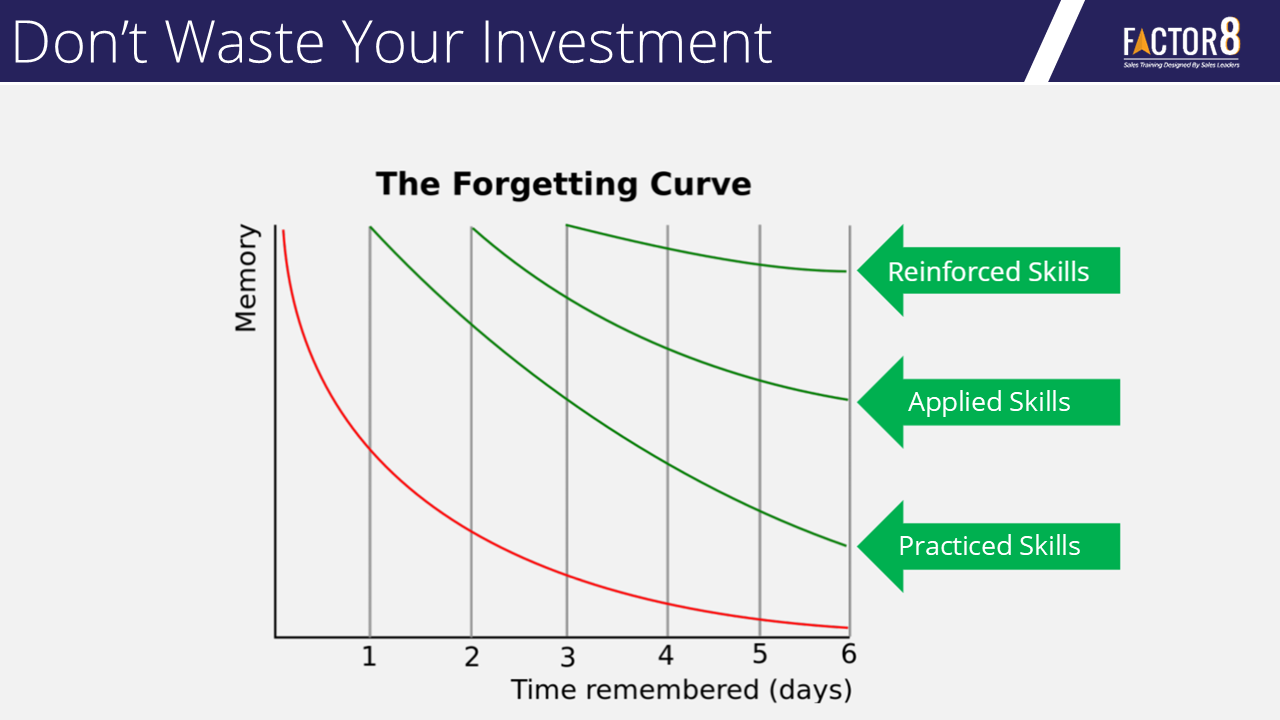How To Build A Sales Manager Cadence (And Save Your Own Life) [Webinar Recording]
How To Build A Sales Manager Cadence (And Save Your Own Life)
[Video Recording]
[Video Recording]


After you’ve hired a sales training vendor, there are a series of questions you need to answer in order to ensure you’re getting the most out of your sales training investment, like:
Having been both the vendor and the buyer in this equation, I definitely have some insight to share. I’ve made mistakes as the Training Director hiring a sales/sales leadership training vendor, and I’ve had clients do some really smart (and less than smart) things.
Although I could write about this topic forever, I’ve narrowed it down to my top 5 tips to maximize your sales training investment.
1. Customize the Customization. Then customize that. Twenty years ago, I paid a vendor $15,000 extra to customize the training for my company. I spent countless hours sending them examples, marketing data, and websites. I forwarded redacted emails and unpublished case studies. I just KNEW they would get the “real feel” for how special our snowflake was. The result?
The vendor added one half-page sheet to the back of the workbook with two custom role plays. TWO! The pages weren’t even numbered with the rest of the workbook. Total afterthought! Literally, nothing else was custom.
Ready for the vendor flipside? Six years ago we up-leveled all our workbooks for Factor 8. This meant I couldn’t build custom workbooks from scratch anymore for clients (the downside of totally custom is a less professional look – even a few errors). Now each of our course workbooks of about 10 pages has around 15 sections in bold red font that our Advisors tailor prior to delivery. It might be the customer’s language, an industry example, a customer voice example, specific sales objections, etc. During the live interactions, our coaches play their sales calls, coach actual delivery, and will give custom samples/scripts of every skill. That’s customization!
Tip: Get an actual list of what is tailored to your organization, its format, and when/how it is delivered.
2. Require Manager Involvement. Note: I didn’t say attendance. You need attendance AND involvement! Back when I was delivering training in an enablement organization, we were afraid to invite all the sales managers to our training. They were so busy and important (and let’s be honest, a little rude). As I gained more confidence, I would meet with them 1:1 after the training with tips on what we trained and what to look for. As I got busier, I would schedule a 15-minute meeting so I could do this all at once. When I was put in charge, I required them to come AND met with them for 30 minutes afterward.
Guess what? They still couldn’t coach the skills. Sure, they attended the training, but they didn’t participate. They didn’t come and play to win as if they, too, would be graded on their adaption of the skills. They half-listened, did some email, smiled and nodded, and stole the stage as often as possible to give sage advice.
Vendor Flipside: At Factor 8, we meet with managers before the training, require attendance at the training, train the managers on how to coach the skills after the training, give managers 3+ tools to make it easy to support and coach the training, then do a follow-up meeting with the managers on how skills went, AND certify the managers to certify the reps on the skills. It may seem like overkill, but trust me, it works.
Your ROI will be cut in half if your managers aren’t underlying the importance of using the new skills and coaching their execution. Go overboard making sure they are trained, incentivized, and supported by your vendor to do this!
3. Measure Your Heart Out! If you aren’t crystal clear on the results, KPIs, and metrics that should be impacted by the training, then you’re not ready to outsource sales training. (Really, a vendor just said that!) In fact, ask the vendor what numbers they expect to move with this engagement (and don’t hire them if they don’t know!) At some point, you’ll have to show your sales training ROI, so define during the interview stage what success looks like and then go get a 3-6 month baseline on these metrics. As a training manager, I was nervous early in my career to do this. It only took one sales leader saying, “You are not solely responsible for the 35% uptick in XYZ…!” for me to start backing down and measuring success anecdotally or with smile sheets. As I grew in my career, all I did was add two words: “contribute to.” If we measure pre and post, we can all SHARE the credit!
Vendor Flipside: I love a case study. Number one reason I don’t have one on every client? They don’t provide us with their reporting. The leader pulls the trigger on the contract and then sales managers or the enablement team are left to execute and the ask never bubbles to the top. In fact, I’d love to take contracts based on the up-side (we get paid when you improve) and have offered it many times in the past, but the baseline metrics and results weren’t available from the client.
4. Get Leadership Involved (more than they are). How do I know they aren’t very involved? I’ve had about 3 clients out of 300 who were. As a training leader, I had about none. Why is this critical? Because your attendees determine how important the training is based on what the leader says, does, and spends money on. Even if you have to write the script for the VP to kick off the meeting and send over the questions they need to ask in their 1:1 meeting afterward, take the time and do it. Otherwise, you may be the flavor of the month.
Vendor Flipside: They’re my favorite three clients ever. And when they ask for anything extra, they get it. I’ve helped them get jobs 10 years later, spoken free at their conferences, and featured them on our blogs. When a leader lends their time, voice, and stature to training, it will literally change the organization’s culture. Help convince them they’ll get more ROI by being involved. Make it easier on them with cheat sheets and reminders. These clients get double their money’s worth.
5. Focus on Long Term. Ever met with an internal client who wants you to train 5 things in 20 minutes? Me too. Try every single sales leader ever. Here’s why: Most people don’t know the difference between telling and training. That’s why their people don’t change their behavior after being told. Folks, if you want people to change what they’re doing, the training will take 5x longer than you want it to AND the support “tail” for the training will be months, maybe even years. Don’t make training an event – studies show they’ll remember about 30% of what is taught. The best leaders get this fact:
Training isn’t something you did, it’s something you do.
Vendor Flipside: Events are fun. They’re low risk and high reward. We often would have better selling days during training than normal days (live calling during training). Lots of energy, buzz, and results. But if that’s all your vendor is doing, reconsider. What about keeping skills alive? Pulling the buzz forward? Seeing skills move from the classroom to the sales floor? 15 years ago we offered a 1-day post-training follow-up. Then 90 days virtual. Now we do one-year contracts. It’s the right thing to do and the right way to do it. Doesn’t fit the SKO? Hire a speaker instead.
If you’re evaluating sales training, we’re here to help. Fill out the form or email info@factor8.com and let us know how we can help.
Contact us today to request information on our customizable virtual sales training programs
available for reps (and managers).
[Video Recording]

Whether you’re shopping around for external inside sales training vendors or working with your internal training department, knowing what good inside sales rep training looks like is the first step to ensuring your training is checking all the key boxes.
We’ve outlined a few of the most important considerations to keep in mind when choosing an inside sales training partner.
This shouldn’t be a surprise to any sales leaders out there — but what makes good inside sales training is results. You’ll be able to know whether or not sales training worked simply because it moved the needle.
These “results” look different depending on your company, team, and goals. It’s important to go into the sales training and decide on what those goals are to you — whether it’s sales units sold or market share gained.
READ: How to Measure Sales Training ROI
This is even more important when partnering with an external sales training vendor. The vendor should understand your goals as well as your sales process, product, customers, industry, and competitors. There is so much specialization in the market today, don’t let a vendor bring SDR training to your team of AEs.
In order for sales training to be considered “good”, it must achieve your goals. Outlining what these goals are, and what success looks like, beforehand is a surefire way to get what your team needs out of their training.
We recommend identifying metrics, behaviors, KPIs, and overall results that you expect to shift during and after the training. Metrics and behaviors should lift immediately showing you’re on the right track, and KPIs are early indicators that the results are on the way. Identifying metrics or results only can lead to a miss.

After the goals are set, here are a few more tips to ensure you’re maximizing your training investment:
Really great sales training is customized to your industry and product/service.
This ensures your reps aren’t left trying to figure out how to take a broad theory and apply it to their job, customer, or service.
While it’s true that customized sales training is more expensive, the ROI is up to twenty-fold when you consider how much your reps are actually retaining, and how much they can apply immediately to their practices.
Use public seminars and events to help someone get a tip or two. Use custom live training to move the needle on results.
Aberdeen reported that 85% of the sales teams that are considered “best-in-class” utilize professional sales trainers or resources.
Don’t try and turn your managers or reps into trainers. Let’s face it, they’ve got enough on their plates. Plus, even really good managers and reps have no idea how to train — it’s just not their job! They might be excellent at sales, but they have no expertise in training.
Even worse, don’t let your HR department teach sales. They’re great at training and professional facilitation in many areas of your business, but their bailiwick is in company orientation and sexual harassment training — not sales and selling. They may be excellent at training but have no expertise in sales.
See where we’re going with this?
Make sure to bring in someone who is an expert at both training and sales. That’s the secret to good inside sales training, and it’s what the best in class are doing.
If you’re training your inside sales reps, make sure they’re attending an inside sales training. It sounds simple, but oftentimes well-meaning sales team leaders are duped into thinking “sales training” is enough. Shoe-horning your company’s existing field training for your inside team may actually do more damage than good.
Most popular sales books and training curricula deal with a very narrow view of selling: The conversation between Person A and Person B. Anyone who has been working in inside sales for a while can agree that the true issue lies in getting that interaction in the first place.
If your reps are struggling with connecting with decision-makers, getting callbacks, finding the right people, figuring out who to call, and capturing attention at the top of the funnel, then conversation selling and overcoming objections will miss the mark.
Make sure that your inside sales reps are being coached on topics like:
It’s important to make sure other aspects of the strategy are covered as well, so the reps can rely on their managers less for questions such as:

Theory stinks.
During the training, make sure reps are getting on the phones. There’s no reason that training shouldn’t be stopped so that the reps can go try out the skills they’re learning, and role-plays don’t really tell the whole story, do they?
Live calls to live customers using the training guarantees that these training methods are going to be applied. Live calling in a safe space leads to more rep buy-in and builds confidence. When reps see the tactics work in real-time they adopt, apply, and try more often. Training fall-off (the forgetting curve) has the odds stacked against it now!
Make the training stick by actually making calls and building pipeline during training.
Put managers in the reps’ training, and when possible make sure they have their own version of the training class tailored for their needs. Managers need to learn how to recognize the new skills in action, when to coach, how to coach the new skill, when to celebrate it working, and how to keep the momentum alive when the trainers leave. Behavior change lives and dies with the management team, and their buy-in, involvement, and use of the new skills are critical to success.
Ask your vendor how the managers will be involved in retaining the new skills.
READ: Tips for Enablement Leaders to Increase Sales Coaching Focus
You got it, training is a process, not an event. Reps reported a “Lack of Development” as a top 5 challenge every year for the past five years as reported by the American Association of Inside Sales Professionals. Aberdeen also reported missing development opportunities as the number one rep-reported reason for leaving companies.
Deciding to invest in rep development is a smart choice, but be sure you don’t assume that it is “one and done.” Your teams want ongoing opportunities to learn, grow, and advance their careers.
READ: Why Event-Based Sales Training Falls Short
Training Magazine reported an average number of development hours/year/employee at about 48 hours – or four hours/month. Is your internal training team ready to provide this? Most corporate training teams get quickly maxed by providing new hire orientation and onboarding. Manager coaching can fill some of the gaps, but if you’re talking with learning vendors, check their ongoing offerings as well.
Ongoing training will often nurture and advance skills taught onsite – helping check the box of retaining new skills and providing the ongoing development reps crave.
The easiest way to accomplish this is with vendor-provided online skills training or inside sales training courses after their session to brush up on their skills, hone in on their weak spots, and keep skills in practice.
When evaluating sales training software, look for interactive resources such as:
Reps want skills on-demand. Learning should be easy, fun, interactive, and flexible. The old days of long-form narrated slides and sales training videos are over. Anyone who has clicked their way through to the final test (or let it run in the background while doing email) can attest to the fact this isn’t engaging or effective.
Again, look for sales training software to engage your management team as well as the learners. New skills and a culture of development live and die on your front lines. Does the software provide manager resources?
How about fast-reference cheat sheets, coaching guides, or contest ideas? Is it nimble enough to allow quick reference before a big call or team meeting?
Get your sales managers involved in testing your top choices.
Contact us today to learn about our customizable virtual sales training programs
available for reps and managers.

By now you’ve heard that the sales rep onboarding experience is a major factor in how they ramp to quota and ultimately affects how they feel about your company.
There are about 3 million moving parts in an onboarding program since it happens across so many departments, mostly outside of sales. Because of this, it’s easy to lose our way during onboarding. One of the most important hindrances is the lack of investment — both in effort and money — in onboarding.
Insidesales.com did a study that found organizations spend an average of 3x more on rep tools than on rep development, with the average rep having between 5-10 tools. Similarly, Training Magazine found that organizations spend on average 25x more on recruiting than development.
Moreover, Training Magazine tells us that a good onboarding program can cut ramp time and attrition by 50%. If we focus more time on crafting an onboarding program that will help retain the reps we recruit, we save time, money, and energy down the line.
So let’s do this! Here are 8 best practices you can dive into fixing right now.
Let’s dive a little deeper into why and how to integrate these tips into your onboarding.
When building an onboarding program, it’s tempting to start by listing all the things “Johnny” may ever need to know and start from the top. Instead, try slicing off only what Johnny needs to know in month one.
It can be tempting to dive deep into company waters with things like histories, organizational charts, and other detailed and specific areas. It’s more effective to shift this information to the backburner for the time being and focus only on what the new rep needs in the first month to be successful. After all, how often does a customer quiz your rep on key events in the company’s founding?
Onboarding training should mirror what a rep’s day-to-day activities will look like once training is finished during the first month on the job (and only that first month). This ensures reps don’t feel like a fish out of water when the time comes to execute the tactics taught in training.
Why stop at month one? Because we want our reps to come out of onboarding feeling confident! We want them ready to pound the phones and execute what they learned! If we start introducing them to all the sales process complexities, advanced products, and deep conversations, then we run the risk of scaring or overwhelming them.
This is a time when “you don’t know what you don’t know” is a good thing. If your reps will likely spend that first month talking to existing happy customers or cold calling and leaving a lot of voicemails, stop training there. Bring them back later for the rest.
Aberdeen reported that 85% of the sales teams considered “best-in-class” use professional sales trainers or curriculum. But the majority of us outsource our onboarding to HR.
This absolutely does not mean that your sales managers should be the trainers. It means that as a sales leader, you have sales managers and a sales training manager reporting to you (or at least attending your meetings). It could also mean that you have a sales manager who acts as a liaison to training.
But what it definitely means is that you and your sales team all know what is being taught, agree with the how, and are thrilled with what reps can do when they graduate from the onboarding training.
Some companies shy away from investing in an expert for new hires due to the high turnover rate. But, by investing in good sales training and following best practices, companies can reduce new hire turnover rate and save money in the long run.
What we use to teach reps is another balancing act between digital learning and resources and traditional training methods.
Best practice? Use technology for about 30% of your overall curriculum. Much more and we’re missing the opportunity to engage new reps and ensure their first month is lonely and, let’s face it: boring.
Online learning is easiest to leverage for one of the following areas:
Leverage your training department’s learning management system with whatever you’re doing. You’ll want to track what reps have and haven’t done and add a layer of accountability with reporting and testing.
Rep development should be ongoing. Don’t ever fall into the trap of “They’re trained! My job here is done.” That’s akin to the NFL putting players in preseason camp and then stopping practice when the regular season begins.
Development is an ongoing sport.
At Factor 8, we’re huge champions of sending new reps to the phones early and often. But that is with the assumption that they’ll come back to the classroom to address the gaps they find while out on the harsh streets of your sales floor. It’s also assuming that managers are closely keeping track of rep progress and development needs.
How do you facilitate this?
Try to organize the curriculum into three levels:
Between each level we add exercises, activities, assignments, and refreshers to keep the skills top of mind, show new ways to try certain tactics, and help managers engage reps in 1:1 and team skill development. The Sales Bar helps us make all of this accessible on-demand so teams can learn what they want to when they want to while still keeping track. We also drip new content monthly and use leaderboards to keep things fresh and different so users want to log back in.
Use this as an example of the microlearning and ongoing development young reps crave. Millennials expect a certain percentage of learning to be in the classroom and online, and they expect opportunities to develop themselves long after onboarding.
Offering blended learning, leveled learning, and ongoing learning checks all those boxes.
If you’re just starting to build your program or you’re going in to assess yours, start by evaluating what’s being trained. It’s easy to go deep into systems and products, but those are just two of the six components of well-rounded onboarding training:
No two reps are identical when it comes to learning style. Make sure you’re meeting every new hire where they’re at by using a mix of helpful resources.
This includes but is not limited to:
Mixing up these methods not only appeals to reps with different learning styles but also helps keep training exciting and fresh. Who wants to sit and listen to someone else make calls all day and slap a “training” label on it?
If you’re not putting all new hires through the same rep onboarding process, how can you ever tell if what you’re doing is working?
As we said: Different reps have different learning styles, so it is important to remain flexible to an extent. Just make sure you have some core pillars of onboarding training in place so all new hires are experiencing the same process.
This helps you measure KPIs and tweak your processes if weak spots surface.
How many times have your managers set sky-high call quotas for new reps? How many times have they failed to reach it? But, most importantly, how many times has this been documented?
The only thing more frustrating (for both rep and manager) than someone consistently underperforming on quotas, is for there to be nothing in place to fix it moving forward.
Make sure when you’re setting expectations and KPIs for new hire reps that they are based on data. Once you have a fleshed-out onboarding process, it will be easier than ever to keep track of this information.
What if we told you there’s a tool that complements in-person sales training, allows managers to monitor new hire learning during onboarding, and offers a wide variety of inside sales resources?
It’s not magic — it’s The Sales Bar. Fill out the form below to learn more.
Contact us today to request information on our customizable virtual sales training programs
available for reps (and managers).

Learning to be a great sales coach is hard – really hard. It’s the hardest thing we teach new managers who were formally reps. Now, it’s not as hard as climbing Mt. Everest or teaching your grandma how to order presents online, but it’s rough.
It’s the #1 skill that most new managers struggle with. If you’re a naturally phenomenal coach, congrats (seriously!), but the rest of us are struggling. Why? We don’t often know what defines great sales coaching. So let’s break it down…
The lines are often blurred between presenting, training, and sales coaching, especially when we don’t have staff and resources dedicated to each. Why does it matter?
Well, does this sound familiar?
“I’VE TOLD THEM 100 TIMES!!”
We’ve heard it from managers and VPs (and parents 😉 ). It’s rough, folks. If people aren’t retaining what you’re telling them to do, they obviously aren’t going to do it. So we have to back up a few steps and make sure it gets in their brain and sticks.
We define presenting as…Introducing new information through speech often using slides/visual aids.
Watching a webinar? You’re listening to someone presenting. Sitting in a lecture hall in college? That’s presenting.
Now the downside to presenting is something called The Forgetting Curve. If you’re in sales enablement or training, you’ve likely heard of it. It shows us that by the end of the day, reps have lost 50% of what you taught them. In a week, they’ve lost 90%. So it’s pretty obvious why they aren’t doing what you told them to do – they can’t even remember it!
There are two ways you can beat The Forgetting Curve.

Folks the name of the game to get people to do what you need them to do, to get results, to get commission checks is: RECALL. They can’t do it if they can’t remember it.
In order to obtain recall, you need to have good facilitation or training. Unfortunately, most facilitation is broken. You can’t just tell someone to do something and expect them to do it perfectly, they need to practice.
Grab a sheet of paper and draw a picture of the Statue of Liberty based on memory. Assuming your side hustle isn’t as an artist, it’s probably going to look like something a child drew. Why? Well, when was the last time you drew something? Drawing is something we did a lot as a kid until other things became more exciting or interesting. We quit practicing, and when we quit practicing, our skills freeze.
For many of us, teaching is also a skill frozen in time. We think of teaching and we see ourselves sitting in a lecture hall with someone talking at us, telling us what to do. And we know that’s not how people learn.
That’s why we’ve got to redefine teaching and facilitate instead.
We define facilitation using the acronym CUP. It stands for…
By using the CUP method for facilitation, that’s how we beat The Forgetting Curve. Expect 70-80% recall. Get some buy-in along the way, a little practice and roleplay, synthesis with what they do on the job, and you’re looking at 80-90% recall. Plus, you’ll create new habits.
Everyone does it a little differently, but a lot of people confuse sales coaching with leading, but with a few questions sprinkled in.
We define sales coaching as… Ongoing development method used by leaders using questions to inspire and deliver personal feedback on skills.
Pay attention to the bolded words. If you’re just giving people advice or there are 25 people in the room, that’s not coaching. When you’ve got a team of reps in the room, what you’re really doing is presenting.
ACTION: Go and CUP check your virtual sales training. If you’ve got a lot of videos and little practice, people aren’t doing what you tell them to do. Leaders, if you do a lot of announcing without any coaching, follow-up, or roleplays, they’re not doing what you tell them to do. And when it’s something critical like learning how to sell and be successful in new hire onboarding, you’ve got to do all 3.
READ: Why You Need a Sales Training and Enablement Budget
If behavior change is critical, start with the 1-2-3 punch. Begin with the presentation, then facilitate, and then coach. Now, coaching alone CAN be powerful (but not how you think…)
Great coaches have 1 thing in common: they motivate people. Motivation is the key to everything. It affects recall (information + caring = recall).
READ: Tips for Enablement Leaders to Increase Sales Coaching Focus
Our job as managers and coaches is to ensure our reps leave our coaching sessions feeling like superheroes. That’s why we teach the 5:1 method – share 5 positives and 1 area for improvement. It’s also the #1 mistake new managers make. Why? We hear the laundry list of things that went wrong on a sales call and can’t help but tell them every single one of them.
The power of sales coaching is in the questions you ask. Said in another way:
“Leaders who ask more, get more.”
That’s why we coach in questions. It’s called “Instinctive Elaboration”. It’s the secret behind the Factor 8 SWIIFT℠ intro where we’re literally hijacking the brain of the prospect to answer our questions even if they didn’t mean to and it’s why it works to get them talking.
It works like this: how old are you?
Did a number pop in your head? Now it’s halfway out of your mouth.
The brain stops what it’s doing and starts answering questions whether it wants to or not.
Here’s more proof: how much do you weigh?
I know you didn’t want to share it, but you thought it, didn’t you? 🙂
DOWNLOAD: 20 Ways to Increase the Sales Coaching Focus at Work
We’ve spent years mastering the art of coaching and have compiled the best sales coaching questions ever (and they’re backed by science).
1. “Tell me about a time you had to do something similar?”
This helps them connect. Unfortunately, not all of us have the time or tech to do the CUP theory. We use a lot of video, but do videos actually teach? We don’t think so (read more about that here.)
2. “Why are you so good at this?”
You can ask this to anybody in any coaching session and something happens in the brain called “Confirmation Bias”. If you ask them a ‘why’ question, they’ll look for the reason that it’s true. This instantly boosts motivation.
3. “What happens when you knock this out of the park?”
This question builds confidence by creating mental imagery, scientifically known as “Functional Equivalence.” You’ve probably heard it with Olympic athletes where they picture themselves doing their gymnastics routine perfectly in their head and it fires the neurons as if they’re doing it. If you can get your reps to picture success, they’re more likely to achieve it.
There’s also something called the “Pygmalion Effect” which says that if your manager believes in you, you’ll believe in yourself more. Read differently:
“Leaders who expect more, get more.”
4. “What are you most proud of on that call?”
If anybody has reps that beat themselves up a little bit, this question is for you. The brain will search for an answer and find it – guaranteed.
5. “What should we do next?”
This is all about active recall; going in and finding the information in the brain. The other question we ask is “what was the customer thinking?” This is out of our head and our noise and puts ourselves into the shoes of the customer which is what we’re trying to do. It shortens ramp time, folks. Ramp time isn’t about me not knowing it, it’s about me not knowing when to use it. And if we can burn the pathways in the brain to recall the information we need at the right time, that’s how we get people to learn and apply skills faster.
6. “What one thing is most important to work on?”
You can use this in any coaching interaction anywhere and the science behind it is called “Implementation Intention.” Studies show that if you work on one thing and put a plan in place, it’s 2-3x more effective.
Coaching your team is more than just sharing information with them—it’s about really changing the way they think and act. By incorporating presenting, facilitating, and coaching, you’ll move from just talking at your team to actually sparking real behavior change.

Building your sales team development plan and sales training budget for the next year can be daunting. That’s why I’ve compiled tips from my 20+ years in the industry to help make this as painless as possible!
Every year Training Magazine releases its Training Industry report. I read it cover to cover and then pull out some important nuggets of information.
Here are a few that stood out to me:
In today’s sales world, training isn’t just important – it’s critical. We’re short on reps but not on quota, low on training and resources, and everyone’s working from home without role models to learn from. And let’s face it, customers expect more while the flood of (terrible) outreach makes it harder to stand out.
A buddy of mine who used to be the head of sales at Outreach said it used to take 5-7 touches to get a prospect talking, and now, it’s more than double. The noise is real, selling is harder, and ramp times are stretching while tenures are shrinking. So, stop skimping on sales training. It’s tough out there, and our teams need every advantage.
Another reason not to skip out on sales training is these staggering numbers…
TIP: If your team offers ongoing training and development, make sure your HR/recruiting team incorporates that into your job postings!
Ramp time is everything. The reality today? We’re training a lot of fresh-out-of-college sellers (or non-college grads), and the timeline isn’t working in our favor. It’s taking them 6 months just to hit quota, and by month 14, most are already heading for the door. Think about that, over half of our reps don’t make it past 14 months. That’s a huge investment in time and money that we’re throwing away.
So, how do we change this? We need to get reps to quota faster, plain and simple. When they hit quota sooner, they stick around longer. I’ve built new hire programs throughout my career, and I can tell you, sales training works:
Training is the game-changer. When reps feel that early success, they stay. It’s as simple as that.
Seasoned sales leaders know what it was like when we first started out. We didn’t have hand-holding; we figured it out as we went. We manually dialed phones, pressed the record button ourselves, and learned by trial and error. That mindset makes it easy to underestimate how much help today’s reps need. But the truth is, investing in development fixes so many of the issues we see with our teams: from new hires trying to find their footing, to field reps adjusting to virtual, to the small groups left standing after layoffs.
Bottom line: sales skill-building isn’t just nice to have, it’s the key to retention and performance. Let’s start ramping our reps faster and watch the difference it makes.
Download: Top Virtual Sales Challenges
Only about 30% of companies invest in training for their managers, and it shows: 60% of managers fail out of their role within the first year. Shocking? Maybe not. Here’s why budgeting for manager development is so crucial:
Most companies pour their resources into reps because that’s where they see immediate ROI. But here’s the thing: while you might have 100 reps, only 5-6 managers oversee all those reps, customers, and deals. And these managers are BURNT OUT, nearly 50% according to LinkedIn.
I learned just how tough it is when I ran into an old colleague who’s now a Sales Director. At a wedding, I joked, “Hey, Chris, you must love this virtual work setup, right? No commute!” He sighed and said, “Virtual is great for everyone except sales managers. It’s rough.” And he’s right. I’ve had every job in sales and I now own three companies, sales management was my toughest role yet.
Burnout is real, and we expect our managers to be like Ted Lasso, coaching, motivating, and making magic happen. But here’s the difference: Ted spends hours on the practice field, with a 10:1 practice-to-game ratio. Your managers? They’re lucky if they get a 1:50 ratio, squeezing in 5 hours of daily calls and maybe 1 hour of weekly training. And that’s without factoring in new hires. My friend Dave said it best: “We give them about 3 weeks of systems training, then they practice on customers.” Yikes.
Ted lives on the practice field; your managers are stranded on an island. And they’re coaching teams of entry-level reps who lack business acumen and are terrified of the phone.
Moral of the story: budget for manager training. Give your managers the support, skills, and development they need to thrive. They’re the key to getting your teams to quota.
If you need to partner with enablement or revenue leadership, alignment is key. Early on, I learned that my superpower is the whisperer who can translate between revenue and enablement. That’s why I put together the cheat sheet below. Use it to bridge the gap, get aligned, and make sure you’re speaking the same language to get what you need for your reps and managers.
DOWNLOAD: How to Partner with Busy Sales Leaders
When talking to sales leaders, emphasize training before tools. Show them the spend, analyze the processes, and start there. Leaders tend to pull one of three levers when tackling problems: people, process, or tech/tools.
Here’s the issue: leaders are spending double on AI-based tools compared to training. They’d rather buy a shiny new tool than invest in building their team’s skills. Just look at the average number of tools per rep (5-10) and the flood of automated, AI-generated, subpar emails we all get daily. We’re bypassing quality and going straight to consistency and efficiency.
Reps today come with less experience, fewer skills, and more to learn to meet rising customer demands. They don’t have the fundamental selling and communication skills to truly benefit from AI. We need to sit down with our sales leaders and have this conversation: tools are great, but training is essential.

In general, industry standards say you should budget 1-3% of your total annual budget for employee development. But let’s make it easier: budget 2-5% of your employee’s salary for training. And remember, these numbers cover every industry (from forklift drivers to CEOs).
For your sales training budget, we need to be on the higher side—expect sales training cost to be around 3-6% of your reps’ salaries.
Here’s the quick math:
(That’s about $50 for every $1K of salary)
Overall Internal Training Budget
If you’re new to training or enablement budgets, here’s what to ask for based on your company size:
This is your total training budget, not just for external spend. For external training, most companies spend 10-15% of their total budget.
External Sales Training Budget
Here’s a quick look at what companies are spending on external sales training vendors:
Top External Spends
Other spending usually covers tools, learning management systems, and instructional design.
DOWNLOAD: How to Partner with Busy Sales Leaders Checklist
What’s Being Outsourced?
And this isn’t changing anytime soon. According to Training Mag, 89% of companies expect these numbers to stay steady.
What Skills Are We Training?
Since the shift to remote work, communication skills have been the big focus (no shocker there). Other areas getting attention include:
DOWNLOAD: Sales Training Vendor Partner Checklist
If you want to secure budget for sales training, the key is to show ROI or projected ROI. Here are some powerful stats to back you up:
Use these stats to build your case, and don’t forget to show how investing in training impacts the bottom line, whether that’s shortening ramp time, boosting rep performance, or improving retention.

If you’re investing in sales training, make sure you’re squeezing every drop of ROI out of it. Here’s how:
Most companies are training internally for only 4-5 hours a month, and that number has dipped from 5 to closer to 4 over the past year.

Before you drop money on sales training, make sure it’s going to the right places:
Where to Spend Your Money:
Where Not to Waste Your Money:
If you’re investing in virtual training specifically, make sure it checks these boxes for maximum effectiveness:
Crafting a sales team development plan and a sales training budget is no small task, but with the right approach, it can unlock your team’s potential and set them up for success in the year ahead. Ready to take the next step? Let us help you create a winning plan and budget! Schedule a call with us today to get started!
Contact us today to learn about our customizable virtual sales training programs
available for reps (and managers).
[Video Recording]

Lauren Bailey, known to many as “LB”, is a sales leader, enablement leader, and entrepreneur and founder of 3 successful brands: Factor 8, providing front-line job training for inside sellers and managers, The Sales Bar, a subscription-based virtual sales training platform, and #GirlsClub, a community and development program helping more women earn leadership positions in sales.

Lori Richardson is a sales process and leadership expert who helps mid-sized company leaders build top sales teams through the right people, processes, pipeline and leadership moves. Lori is a sales coach at Harvard Business School for their MBA students, hosts an award-winning podcast, and is author of “She Sells – Find, Hire, and Retain Great Women in B2B Sales” Founder of Score More Sales, you can find her @scoremoresales on most social platforms.